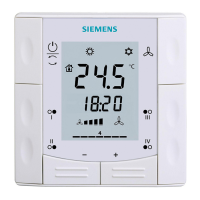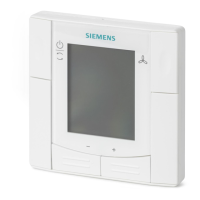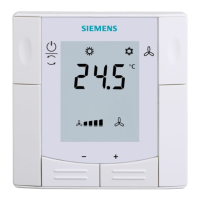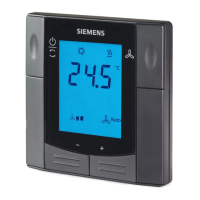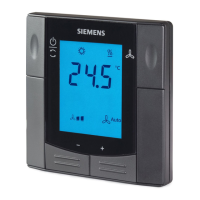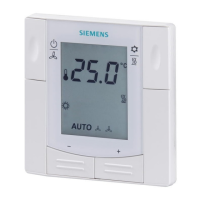64 / 92
Siemens RDF301, RDF301.50..., RDF600KN, RDF600KN/VB, RDF600KN/S Basic Documentation CE1P3171en
Smart Infrastructure 2020-02-21
Obj Object name Function Type/ length Flags
30 Heating / cooling
changeover
Heat /
Cool
1.100
1 bit
CWU
Changeover information transmitted via bus.
Default: Current mode before power down.
The same function is also available via local multifunctional input
X1/X2 (parameter P38, P40).
Only one input source must be used, either local input X1/X2 or
KNX bus..
31 Application mode HVAC
control
mode
20.105
8 bit
CWU
0 Auto (default) Heating and/or cooling
1 Heat Heating only
2 Morning warmup* Heating only
3 Cool Cooling only
5 Precool* Cooling only
6 OFF Neither heating nor cooling
8 Emergency heat* Heating only
9 Fan only Fan runs at high speed
* Function handled like Heat (1) or Cool (3)
32 Enable fan
command value
Enable
Disable
1.003
1 bit
CWU
Set fan mode to Auto (disable) or Manual (enable) by a KNX
control unit. If Manual, the value received on Fan command value
(34) will be used to command the fan speed.
Default: Enable
The last interaction wins – either from the local fan mode button or
via bus.
33 Fan operation Auto
Manual
1.001
1 bit
CRT
Indicates the status of the fan mode: Auto (0) or Manual (1).
34 Fan command
value
0…100% 5.001
8 bit
CWU
The fan can be set to a specified speed by a KNX control unit
when manual fan operation is enabled.
Speed Fan command value (physical KNX value)
1 1...33% (1…85)
2 34…67% (86...170)
3 68…100% (171…255)
Fan speed "0" is not supported by the thermostat and the fan
speed will remain unchanged.
35 Fan output 0…100% 5.001
8 bit
CRT
Indicates the current fan speed as a value 0...100%
Speed Fan output (physical KNX value)
OFF 0% (0)
1 33% (84 )
2 66% (186)
3 100% (255)
36
37
38
Fan speed 1
Fan speed 2
Fan speed 3
ON
OFF
1.001
1 bit
CRT
Indicate the state of the relay outputs
39
40
X1: Temperature
X2: Temperature
Temp.
value
9.001
2 Byte
CRT
Indicate the values of the temperature sensors connected to the
local inputs X1 / X2
41
42
X1: Digital
X2: Digital
ON
OFF
1.001
1 bit
CRT
Indicate the status of the digital inputs (adjusted by parameters
P39/P41) including considering of operating action
44 Outside
temperature
Temp.
value
9.001
2 Byte
CWU
The outside temperature measured by a KNX sensor can be
displayed on the thermostat, if parameter P07 "Additional user
information" is set = 2 (outside temperature).
Obj Object name Function Type/ length Flags
45 Buttons left
ON/OFF
ON
OFF
1.001
1 bit
CT
51 Buttons right
ON/OFF
Switch control: Parameter ON/OFF functions = Top: ON; Bottom:
OFF
When pressing the button, the corresponding switching telegram is
sent immediately.
45 Button
top left: ON/OFF
ON
OFF
1.001
1 bit
CT
CWTU 1)
46 Button
bottom left: ON/OFF
51 Button
top right: ON/OFF
52 Button
bottom: Right
ON/OFF
Switch control: Parameter ON/OFF functions = 2 "ON/OFF"
functions.
When pressing the button, the corresponding switching telegram is
sent immediately: ON, OFF or Toggle.
1) If "Toggle" is selected, the communication object becomes
output and synchronization input
45
51
Buttons left:
ON/OFF
Buttons right:
ON/OFF
ON
OFF
1.001
1 bit
CT
47
53
Buttons left: Dim
up/down
Buttons right:
Dim up/down
Darker /
Brighter
1.001
4 bit
CT
On a short operation of the button, a switching telegram is sent,
e.g. press left top button: "On" is sent, press left bottom button:
"OFF" is sent.
When pressing the buttons longer, a dimming telegram is sent,
e.g. press left top button: "Brighter" is sent, press left bottom
button: "Darker" is sent.
On releasing the button, a "Stop" telegram is sent.
48
54
Buttons left:
Blind step/stop
Buttons right:
Blind step/stop
Step /
Stop
1.001
1 bit
CT
49
55
Buttons left:
Blind up/down
Buttons right:
Blind up/down
Up /
Down
1.001
1 bit
CT
On a short operation of the button, a telegram is sent to adjust the
louvers or stop the blinds if moving up or down.
On a long operation of the button, a telegram is sent to raise or
lower the blinds (up or down)
50
56
Buttons left:
Scene
Buttons right:
Scene
Scene
control
18.001
8 bit
CT
The "Scene (8-bit)" function is used to change the characteristics
of a preset scene, i.e. brightness levels and switching states of a
group within a scene, without using the ETS.
For scene control, short and long (<1 s / > 3 s) pressing on the
buttons are distinguished.
On a short press, a telegram is sent to recall the corresponding
scene. On a long press, a telegram is sent to save the corres-
ponding scene.
For each button a different scene number can be configured in
ETS.
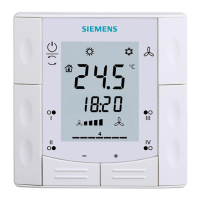
